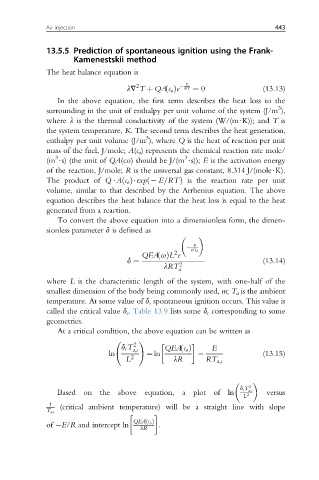Page 479 - Enhanced Oil Recovery in Shale and Tight Reservoirs
P. 479
Air injection 443
13.5.5 Prediction of spontaneous ignition using the Frank-
Kamenestskii method
The heat balance equation is
2 E
lV T þ QAðc o Þe RT ¼ 0 (13.13)
In the above equation, the first term describes the heat loss to the
3
surrounding in the unit of enthalpy per unit volume of the system (J/m ),
where l is the thermal conductivity of the system (W/(m$K)); and T is
the system temperature, K. The second term describes the heat generation,
3
enthalpy per unit volume (J/m ), where Q is the heat of reaction per unit
mass of the fuel, J/mole; A(c o ) represents the chemical reaction rate mole/
3 3
(m $s) (the unit of QA(co) should be J/(m $s)); E is the activation energy
of the reaction, J/mole; R is the universal gas constant, 8.314 J/(mole$K).
The product of Q $Aðc o Þ$expð E=RTÞ is the reaction rate per unit
volume, similar to that described by the Arrhenius equation. The above
equation describes the heat balance that the heat loss is equal to the heat
generated from a reaction.
To convert the above equation into a dimensionless form, the dimen-
sionless parameter d is defined as
E
RTa
2
QEAðcoÞL e
(13.14)
lRT a
d ¼ 2
where L is the characteristic length of the system, with one-half of the
smallest dimension of the body being commonly used, m; T a is the ambient
temperature. At some value of d, spontaneous ignition occurs. This value is
called the critical value d c . Table 13.9 lists some d c corresponding to some
geometries.
At a critical condition, the above equation can be written as
2 !
d c T a;c E
ln ¼ ln QEAðc o Þ (13.15)
L 2 lR RT a;c
d c T 2
Based on the above equation, a plot of ln a;c versus
L 2
1 (critical ambient temperature) will be a straight line with slope
T a;c
of E/R and intercept ln QEAðc o Þ .
lR

